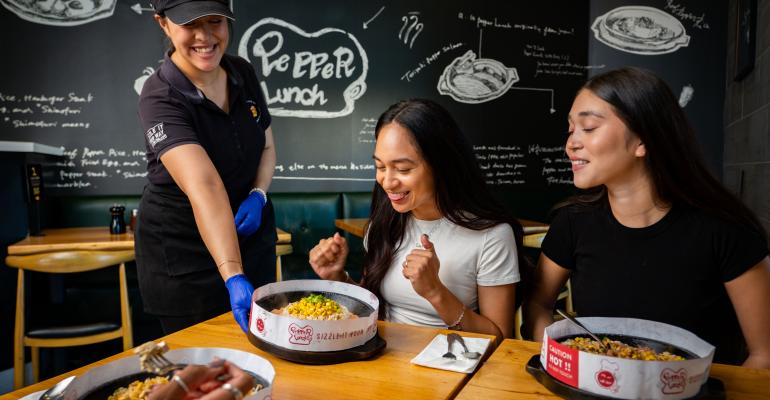Pepper Lunch has been around for nearly 30 years, expanding to about 500 locations in Japan and over a dozen other Asian markets. Despite having five existing locations in the U.S., the market has never been a major priority for the company.
That changed last year when Hot Palette America Incorporated was organized in California to franchise Pepper Lunch restaurants in the U.S. and Canada. Earlier this year, the company named industry veteran Troy Hooper as its CEO to spearhead its growth, driven by a new franchising program. During a recent interview, Hooper made it clear he wasn’t looking for this type of role, but the more he heard about the concept, the more he was hooked.
“The service and guest experience are unique and special, and the food is authentic, yet approachable. I’m adventurous, but I’m also pretty hesitant when it comes to Asian foods because some can be pretty exotic,” Hooper said. “When I saw this menu, it wasn’t intimidating. We don’t have to do a ton of menu education; people could stumble into the brand and have a great meal. That was one of several green checkmarks for me.”
So, what exactly is Pepper Lunch? His elevator pitch is that it’s an experiential fast casual, Japanese hot plate concept that uses authentic ingredients and recipes from its home market. There is a do-it-yourself component, as dishes are served on a 500-degree hot plate and allow for customers to mix in their sauces and spices to their preference, alongside rice, veggies and proteins. The average price point is $17.50.
It may seem a bit unique to those outside of its five U.S. markets – three in California, one in Houston, and one in Las Vegas – but Hooper thinks Pepper Lunch has the potential to put fast casual Japanese cuisine on the map in the same way Halal Guys has done for American halal cuisine, and Curry Up Now has done for Indian Street Food. And he believes the timing is right, pointing to the recent IPO of full-service concept Gen Korean BBQ – which also uses a unique cooking technique from embedded table grills – as an example.
“We give you the same quality ingredients and same experience, but we do it in a third of the time for half price,” Hooper said.
The staggering increase in demand for Asian cuisine also supports the timing of Pepper Lunch’s anticipated growth. According to Pew Research, 73% of all U.S. counties now have at least one Asian restaurant.
“The reality is, we’re able to attach ourselves to the generality of Asian cuisine discovery, which is at an all-time high. We know that 60% of that discovery is under 30 years old. This expands the opportunity of where we can go and gives us a 10-year trajectory of growth. There is a lot of white space opportunity for the longevity of this brand,” Hooper said.
That opportunity includes a projected 55 agreements signed by the end of this year. Hooper thinks the U.S. can handle 600 locations, with over 350 of those open in seven years.
“It sounds aggressive, but it feels very comfortable for us,” he said. “And we have proof of concept. The five stores we have open show that people are eating our food at volume. Those restaurants haven’t just survived, but thrived, and that is something we can work with.”
According to the company’s FDD, AUVs range from about $900,000 to about $2.9 million. Hooper also likes that the fast casual model creates more format flexibility. In its international markets, for example, Pepper Lunch exists in spaces from a 300-quare-foot kiosk to a 2,200-square-foot traditional restaurant. And, because the concept has a large DIY component, the operational model is simple.
“The financial metrics are fantastic. Our economics come from flexible real estate models and low- and no-skill labor. We do significant volumes. The average fast casual benchmarks about 320-to-380 covers a day and we’re well north of 400 per location,” Hooper said. “And because our supply chain is well established, our food costs are in the low 20s (percentage) and our labor costs are in the low 20s. We cover our costs faster than most.”
Hooper claims these “fantastic” numbers are generating plenty of interest from potential franchisees to support its short-and-long-term growth aspirations, many of whom are experienced multi-unit operators in the industry and many of whom are familiar with the concept.
“That is what is energizing me. The folks who are calling picked up the phone because they know the brand, they experienced it somewhere, and they’ve bought in,” Hooper said. “They know that there isn’t just one thing that makes this brand special, and they see the white space opportunities. We believe we’re in a category of one.”
Contact Alicia Kelso at [email protected]





